UAV-Based Servicing of IoT Nodes: Assessment of Ecological Impact
Abstract
:1. Introduction
2. System and IoT Node Architecture and Related Work
- 1.
- Using uncoupled wireless power transfer approaches such as laser power transfer or radio frequency (RF) power transfer to recharge the IoT node’s batteries. These techniques feature wireless power over longer distances combined with lower efficiencies compared with the coupled WPT techniques [4].
- 2.
- Engaging UVs deployed as a mobile power bank to charge batteries on-site.
- 3.
- Employing UVs acting as a technician to replace batteries autonomously.
2.1. Uncoupled Wireless Power Transfer
2.2. UV with Charging Facility
2.3. IoT Energy Storage Replacement
2.4. UAV Energy Consumption Model
2.4.1. Completing the Proposed Model
Experimental Measurement 1: Hovering UAV with Payloads
Experimental Measurement 2: Vertical Movements
Experimental Measurement 3: Steady-Level Flight
2.4.2. Optimal Energy Per Meter
2.4.3. Travel Energy
3. Models for Energy Provisioning
3.1. Powering IoT Devices with RFPT
3.1.1. Required Effective Isotropic Radiated Power
3.1.2. Regulatory Restrictions
3.1.3. Power Amplifier
3.2. Energy Delivery to Battery-Powered Devices
- 1.
- UAV flight and avionics consumption is a combination of hovering, ascending, descending, and steady-level flight energy. The model for the UAV is detailed in Section 2.4. The total energy consumption to fly to the node’s location and vice versa is called the total travel energy and is given in Section 2.4.3.
- 2.
- The selected energy storage at the IoT node determines the charge rate and the amount of power transmitted to the node. A brief overview is given in Section 3.2.1.
- 3.
- Power transfer technology between the UAV and IoT node imposes additional constraints on the system, such as limited distance between WPT-transmitter and receiver, efficiency, losses, and maximum transferable power, as discussed in Section 3.2.2.
3.2.1. Energy Storage Selection
3.2.2. Energy Transfer Link
3.2.3. Limitations of IoT Storage Capacity
- 1.
- The travel energy from Equation (9) for the outward and return flights. We multiply the traveling energy by two. Although, if and are different, there is a small deviation between the outward and return travel energy present. This small deviation is neglected here.
- 2.
- The hovering energy , which depends on the charge time and hovering power from Equation (6).
- 3.
- The total amount of energy consumed by the WPT transmitter , with the efficiency determined by the energy delivered by the UAV battery relative to the energy stored in the node.
3.2.4. Duration of an Intervention
3.3. Swapping Embedded Batteries
4. Comparative Survey and Results
4.1. Figure of Merit Analysis
- (S1)
- Section 2.1 describes an RFPT SISO system. Since this can theoretically be switched on indefinitely, and hence time is not an issue, the power consumption is the main focus. The efficiency is calculated through the relation between DC output power and DC input power.
- (S2)
- Section 3.2 rather concentrates on providing energy on site. The efficiency is defined by the stored energy in the IoT device related to consumed UAV energy.
- (S3)
- The approach, explained in Section 3.3, requires another FoM calculation to evaluate the performance. The UAV with battery-swapping capabilities transports energy based on a separate energy storage medium, i.e., a reusable battery. The energy efficiency here no longer depends on how efficiently the UAV’s battery is used but rather on the amount of energy delivered compared with the amount of initial energy. This initial energy is made up of the combined capacities of the carried and UAV batteries.
4.1.1. Radio Frequency Power Transfer Efficiency
4.1.2. UAV as Mobile Powerbank: Overall Efficiency
4.1.3. Swapping IoT Batteries: Overall Efficiency
4.2. Figure of Merit Comparison and Overall Discussion
- (Cf. 1)
- Battery swapping, even with a full payload, is more efficient than in situ wireless battery recharging. In this case, the UAV consumption is even smaller than the transported energy. Figure 17 already showed that higher payloads lead to higher FoM values, although an amount of 68.3 kJ of rechargeable IoT storage is rather unrealistic for low-power IoT integrations. They do not benefit from an oversized battery, since this reduces the environmental friendliness of the approach. A more energy-efficient solution is to use the full payload capability, which means transporting multiple IoT batteries at the same time to serve more devices in a given area. This analysis is not covered in this study.
- (Cf. 2)
- An equally large IoT battery capacity of 5 kJ with a similar FoM demonstrates that the swapping process appears to be the most advantageous once again. In this case, the distance can reach 2.6 km further located nodes while maintaining the same FoM value.
- (Cf. 3)
- If both numbers of UAV batteries, travel distance, and storage capacity are assumed equal, the swapping process is still advantageous. Furthermore, the UAV battery may preserve a significant amount of residual energy.
- (Cf. 4)
- Continuing on (Cf. 3), the difference in FoM values becomes smaller with increasing distance. In this example, there is only a 2.5% difference. Obviously, the remaining SoC is higher when swapping, since the charge energy comes from the UAV battery.
4.3. UAV Optimizations
5. Other Ecological Considerations and Future Work
5.1. Impact Comparison
5.2. Scarcity of Elements
| Cobalt | Cadmium | Chromium | Lithium | Nickel | Manganese | Phosphor | Vanadium | Zirconium | Fluor | Iron | Kalium | Aluminum | Titanium | ||
|---|---|---|---|---|---|---|---|---|---|---|---|---|---|---|---|
| Nickel manganese cobalt | NMC | x | x | x | x | x | x | ||||||||
| Lithium cobalt oxide | LCO | x | x | x | x | ||||||||||
| Nickel cobalt aluminum | NCA | x | x | x | x | x | x | ||||||||
| Lithium iron phosphate | LFP | x | x | x | x | ||||||||||
| Lithium titanate | LTO/NMC | x | x | x | x | x | x | x | |||||||
| Nikkel cadmium | NiCd | x | x | x | x | ||||||||||
| Nikkel metal hydride | NiMH | x | x | x | x | x | x | x | x |
5.3. Manual Labor Comparison
5.4. Future Work
6. Conclusions
Author Contributions
Funding
Institutional Review Board Statement
Informed Consent Statement
Data Availability Statement
Conflicts of Interest
Abbreviations
| AUV | Autonomous Underwater Vehicle |
| BOM | Bill of Materials |
| BLDC | Brushless DC |
| CC | Constant Current |
| CPT | Capacitive Power Transfer |
| CV | Constant Voltage |
| DC | Direct Current |
| DE | Drain Efficiency |
| EASA | European Union Aviation Safety Agency |
| EDLC | Electrostatic Double-Layer Capacitors |
| EIRP | Effective Isotropic Radiated Power |
| EoL | End of Life |
| ERP | Effective Radiated Power |
| ESC | Electronic Speed Control |
| ETSI | European Telecommunications Standards Institute |
| FoM | Figure of Merit |
| GWP | Global Warming Potential |
| IoT | Internet of Things |
| IPT | inductive power transfer |
| ISM | Industrial, Scientific, and Medical |
| LCA | life cycle assessment |
| LCO | lithium cobalt oxide |
| LIC | lithium-ion capacitor |
| LFP | lithium iron phosphate |
| Li-ion | lithium-ion |
| LiPo | lithium polymer |
| LoRaWAN | long-range wide-area network |
| LoS | line-of-sight |
| LPT | laser power transfer |
| LS | least squares |
| LTC | lithium thionyl chloride |
| LTO | lithium titanate |
| MCU | Microcontroller Unit |
| NCA | nickel cobalt aluminum |
| NiCd | nikkel cadmium |
| NiMH | nikkel metal hydride |
| NMC | nickel manganese cobalt |
| PA | power amplifier |
| PAE | power-added efficiency |
| RF | radio frequency |
| RFID | radio frequency identification |
| RFPT | radio frequency power transfer |
| SISO | single-input single-output |
| SoC | state of charge |
| UAV | unmanned aerial vehicle |
| UGV | unmanned ground vehicle |
| UV | unmanned vehicle |
| WPT | wireless power transfer |
References
- Blog, A.C. White Paper: Economics of a Trillion Connected Devices. 2022. Available online: https://community.arm.com/arm-community-blogs/b/internet-of-things-blog/posts/white-paper-the-route-to-a-trillion-devices (accessed on 26 November 2022).
- Callebaut, G.; Leenders, G.; Van Mulders, J.; Ottoy, G.; De Strycker, L.; Van der Perre, L. The Art of Designing Remote IoT Devices—Technologies and Strategies for a Long Battery Life. Sensors 2021, 21, 913. [Google Scholar] [CrossRef]
- Moore, S. Lessons From IoT Early Adopters. 2018. Available online: https://www.gartner.com/smarterwithgartner/lessons-from-iot-early-adopters (accessed on 1 December 2022).
- Van Mulders, J.; Delabie, D.; Lecluyse, C.; Buyle, C.; Callebaut, G.; Van der Perre, L.; De Strycker, L. Wireless Power Transfer: Systems, Circuits, Standards, and Use Cases. Sensors 2022, 22, 5573. [Google Scholar] [CrossRef]
- Frequency Identification Equipment Operating in the Band 865 MHz to 868 MHz with Power Levels Up to 2 W and in the Band 915 MHz to 921 MHz with Power Levels Up to 4 W; Harmonised Standard for Access to Radio Spectrum; European Telecommunications Standards Institute: Sophia-Antipolis, France, 2020.
- Clerckx, B.; Bayguzina, E. Waveform design for wireless power transfer. IEEE Trans. Signal Process. 2016, 64, 6313–6328. [Google Scholar] [CrossRef] [Green Version]
- Li, Z.; Zeng, M.; Tan, H.Z. A multi-band rectifier with modified hybrid junction for RF energy harvesting. Microw. Opt. Technol. Lett. 2018, 60, 817–821. [Google Scholar] [CrossRef]
- Consortium, R. REsilient INteractive Applications through Hyper Diversity in Energy Efficient RadioWeaves Technology. Available online: https://reindeer-project.eu/ (accessed on 7 December 2022).
- Van der Perre, L.; Larsson, E.G.; Tufvesson, F.; De Strycker, L.; Björnson, E.; Edfors, O. RadioWeaves for efficient connectivity: Analysis and impact of constraints in actual deployments. In Proceedings of the 2019 53rd Asilomar Conference on Signals, Systems, and Computers, Pacific Grove, CA, USA, 3–6 November 2019; pp. 15–22. [Google Scholar]
- Van Mulders, J.; Leenders, G.; Callebaut, G.; De Strycker, L.; Van der Perre, L. Aerial Energy Provisioning for Massive Energy-Constrained IoT by UAVs. In Proceedings of the 2022 IEEE International Conference on Communications (ICC): IoT and Sensor Networks Symposium (IEEE ICC’22—IoTSN Symposium), Seoul, Republic of Korea, 16–20 May 2022; pp. 3574–3579. [Google Scholar] [CrossRef]
- EASA. Open Category—Civil Drones. Available online: https://www.easa.europa.eu/en/domains/civil-drones/drones-regulatory-framework-background/open-category-civil-drones. (accessed on 3 November 2022).
- Tiurlikova, A.; Stepanov, N.; Mikhaylov, K. Wireless power transfer from unmanned aerial vehicle to low-power wide area network nodes: Performance and business prospects for LoRaWAN. Int. J. Distrib. Sens. Netw. 2019, 15, 1550147719888165. [Google Scholar] [CrossRef] [Green Version]
- Li, Y.; Zhou, C.; Shi, S.; Xu, Z. Time Allocation in Multi-UAV Energy Harvesting Network. In Proceedings of the International Conference on Artificial Intelligence for Communications and Networks, Xining, China, 23–24 October 2021; pp. 8–19. [Google Scholar]
- Cheng, C.; Adulyasak, Y.; Rousseau, L.M. Drone routing with energy function: Formulation and exact algorithm. Transp. Res. Part B Methodol. 2020, 139, 364–387. [Google Scholar] [CrossRef]
- Haider, S.K.; Nauman, A.; Jamshed, M.A.; Jiang, A.; Batool, S.; Kim, S.W. Internet of Drones: Routing Algorithms, Techniques and Challenges. Mathematics 2022, 10, 1488. [Google Scholar] [CrossRef]
- Pugliese, L.D.P.; Guerriero, F.; Macrina, G. Using drones for parcels delivery process. Procedia Manuf. 2020, 42, 488–497. [Google Scholar] [CrossRef]
- Zhang, J.; Campbell, J.F.; Sweeney, D.C., II; Hupman, A.C. Energy consumption models for delivery drones: A comparison and assessment. Transp. Res. Part D Transp. Environ. 2021, 90, 102668. [Google Scholar] [CrossRef]
- Dorling, K.; Heinrichs, J.; Messier, G.G.; Magierowski, S. Vehicle Routing Problems for Drone Delivery. IEEE Trans. Syst. Man Cybern. Syst. 2017, 47, 70–85. [Google Scholar] [CrossRef] [Green Version]
- Ferrandez, S.M.; Harbison, T.; Weber, T.; Sturges, R.; Rich, R. Optimization of a truck-drone in tandem delivery network using k-means and genetic algorithm. J. Ind. Eng. Manag. 2016, 9, 374–388. [Google Scholar] [CrossRef] [Green Version]
- Kirschstein, T. Comparison of energy demands of drone-based and ground-based parcel delivery services. Transp. Res. Part D Transp. Environ. 2020, 78, 102209. [Google Scholar] [CrossRef]
- Liu, Z.; Sengupta, R.; Kurzhanskiy, A. A power consumption model for multi-rotor small unmanned aircraft systems. In Proceedings of the 2017 International Conference on Unmanned Aircraft Systems (ICUAS), Miami, FL, USA, 13–16 June 2017; pp. 310–315. [Google Scholar] [CrossRef]
- e-Peas Semiconductors. E-Peas RF Energy Harvesting Datasheet AEM40940 Rev. 1.1. 2018. Available online: https://e-peas.com/wp-content/uploads/2020/04/E-peas_RF_Energy_Harvesting_Datasheet_AEM40940.pdf (accessed on 7 November 2022).
- Kazimierczuk, M.K. RF Power Amplifiers; John Wiley & Sons: Hoboken, NJ, USA, 2014. [Google Scholar]
- Ronsmans, J.; Lalande, B. Combining energy with power: Lithium-ion capacitors. In Proceedings of the 2015 International Conference on Electrical Systems for Aircraft, Railway, Ship Propulsion and Road Vehicles (ESARS), Aachen, Germany, 3–5 March 2015; pp. 1–4. [Google Scholar] [CrossRef]
- Mauger, A.; Julien, C. Critical review on lithium-ion batteries: Are they safe? Sustainable? Ionics 2017, 23, 1933–1947. [Google Scholar] [CrossRef] [Green Version]
- Tecate GROUP. TYPE TPLC HYBRID CAPACITOR (LIC). 2022. Available online: https://www.tecategroup.com/products/data_sheet.php?i=TPLC-3R8/50MR10X20 (accessed on 7 November 2022).
- Wireless Power Consortium. Qi Specification Power Delivery. 2021. Available online: https://www.wirelesspowerconsortium.com/knowledge-base/specifications/download-the-qi-specifications.html (accessed on 7 November 2022).
- Alliance, A. AirFuel Is Cutting the Cord. Available online: https://airfuel.org/wireless-power/ (accessed on 10 November 2022).
- Rindorf, L.; Lading, L.; Breinbjerg, O. Resonantly coupled antennas for passive sensors. In Proceedings of the SENSORS, 2008 IEEE, Lecce, Italy, 26–29 October 2008; pp. 1611–1614. [Google Scholar]
- Mei, J.; Cheng, E.K.; Fong, Y. Lithium-titanate battery (LTO): A better choice for high current equipment. In Proceedings of the 2016 International Symposium on Electrical Engineering (ISEE), Santa Clara, CA, USA, 8–10 June 2016; pp. 1–4. [Google Scholar]
- GWL. LTO1865-13 Rechargeable Cell. Available online: https://files.gwl.eu/inc/_doc/attach/StoItem/7015/GWL_LTO1865_Rechargeable.pdf (accessed on 7 November 2022).
- CUSTOMCELLS. LTO/NMC 622—High Power Cells. 2017. Available online: https://www.customcells.de/fileadmin/customcells/Dokumente/Newsletter/CUSTOMCELLS-Newsletter-2017-09-01-LTO-cells.pdf (accessed on 7 November 2022).
- SAMSUNG SDI. INR18650-29E. 2012. Available online: https://eu.nkon.nl/sk/k/29E.pdf (accessed on 7 November 2022).
- NX. 18650 LIFEPO4 BATTERY 1500mAh 3.2V. 2014. Available online: https://docs.rs-online.com/1683/0900766b812fdd11.pdf (accessed on 7 November 2022).
- Panasonic. Lithium Ion NCR18650B. 2012. Available online: https://www.batteryspace.com/prod-specs/NCR18650B.pdf (accessed on 7 November 2022).
- Sanyo Cadnica. Cell Type N-700AAC. Available online: https://www.omnitron.cz/_dokumenty/2782019153700772/n-700aac–77.pdf (accessed on 7 November 2022).
- RS PRO. NI-MH LOW-SELF DISCHARGE. Available online: https://docs.rs-online.com/686b/0900766b81585e4a.pdf (accessed on 7 November 2022).
- Lee, D.; Zhou, J.; Lin, W.T. Autonomous battery swapping system for quadcopter. In Proceedings of the 2015 International Conference on Unmanned Aircraft Systems (ICUAS), Denver, CO, USA, 9–12 June 2015; pp. 118–124. [Google Scholar] [CrossRef]
- Suzuki, K.A.; Kemper Filho, P.; Morrison, J.R. Automatic battery replacement system for UAVs: Analysis and design. J. Intell. Robot. Syst. 2012, 65, 563–586. [Google Scholar] [CrossRef]
- Johansson, T.; Fritzin, J. A review of watt-level CMOS RF power amplifiers. IEEE Trans. Microw. Theory Tech. 2013, 62, 111–124. [Google Scholar] [CrossRef] [Green Version]
- Blouin, C. How to Increase Drone Flight Time & Lift Capacity. 2021. Available online: https://www.tytorobotics.com/blogs/articles/how-to-increase-drone-flight-time-and-lift-capacity (accessed on 7 November 2022).
- Ahmad, K. Lithium-Ion Batteries vs. Lithium-Polymer: Which One’s Better? 2022. Available online: https://www.makeuseof.com/lithium-ion-vs-lithium-polymer-which-is-better/ (accessed on 7 November 2022).
- Long, T.; Ozger, M.; Cetinkaya, O.; Akan, O.B. Energy Neutral Internet of Drones. IEEE Commun. Mag. 2018, 56, 22–28. [Google Scholar] [CrossRef] [Green Version]
- Pirson, T.; Bol, D. Assessing the embodied carbon footprint of IoT edge devices with a bottom-up life-cycle approach. J. Clean. Prod. 2021, 322, 128966. [Google Scholar] [CrossRef]
- Ember. Data Explorer. Available online: https://ember-climate.org/data/data-explorer/ (accessed on 7 November 2022).
- Sadhukhan, J.; Christensen, M. An In-Depth Life Cycle Assessment (LCA) of Lithium-Ion Battery for Climate Impact Mitigation Strategies. Energies 2021, 14, 5555. [Google Scholar] [CrossRef]
- Melin, H.E. Analysis of the Climate Impact of Lithium-Ion Batteries and How to Measure It; Circular Energy Storage-Research and Consulting: London, UK, 2019; pp. 1–17. [Google Scholar]
- Philippot, M.; Alvarez, G.; Ayerbe, E.; Van Mierlo, J.; Messagie, M. Eco-efficiency of a lithium-ion battery for electric vehicles: Influence of manufacturing country and commodity prices on ghg emissions and costs. Batteries 2019, 5, 23. [Google Scholar] [CrossRef] [Green Version]
- Sánchez, D.; Proske, M.S.J.B. Life Cycle Assessment of the Fairphone 4. 2022. Available online: https://www.fairphone.com/wp-content/uploads/2022/07/Fairphone-4-Life-Cycle-Assessment-22.pdf (accessed on 7 November 2022).
- Masanet, E.; Horvath, A. Single-Use Alkaline Battery Case Study The Potential Impacts of Extended Producer Responsibility (EPR) in California on Global Greenhouse Gas (GHG) Emissions; California Department of Resources Recycling and Recovery: Sacramento, CA, USA, 2012. [Google Scholar]
- Olivetti, E.; Gregory, J.; Associates, C. Life Cycle Assessment of Alkaline Battery Recycling a Report for the Corporation for Battery Responsibility Executive Summary; Massachusetts Institute of Technology: Cambridge, MA, USA, 2018. [Google Scholar]
- Ciobanu, E. Drone Life Expectancy (How Long Do Drones Last?). Available online: https://www.droneblog.com/drone-life-expectancy/ (accessed on 7 November 2022).
- Agency, E.E. Greenhouse Gas Emission Intensity of Electricity Generation. Available online: https://www.eea.europa.eu/data-and-maps/daviz/co2-emission-intensity-12/#tab-googlechartid_chart_11 (accessed on 7 November 2022).
- Science, L. Europe’s ’New’ Periodic Table Predicts Which Elements Will Disappear in the Next 100 Years. Available online: https://www.livescience.com/64596-new-periodic-table-shows-helium-scarcity.html (accessed on 7 November 2022).
- Panasonic. Lithium-ion Batteries Product Information Sheet; Panasonic: Osaka, Japan, 2017. [Google Scholar]
- Kurzweil, P. Chapter 19—Electrochemical Double-layer Capacitors. In Electrochemical Energy Storage for Renewable Sources and Grid Balancing; Moseley, P.T., Garche, J., Eds.; Elsevier: Amsterdam, The Netherlands, 2015; pp. 377–379. [Google Scholar] [CrossRef]
- University, B. BU-205: Types of Lithium-Ion. 2021. Available online: https://batteryuniversity.com/article/bu-205-types-of-lithium-ion (accessed on 7 November 2022).
- Ebin, B.; Petranikova, M.; Ekberg, C. Physical separation, mechanical enrichment and recycling-oriented characterization of spent NiMH batteries. J. Mater. Cycles Waste Manag. 2018, 20, 2018–2027. [Google Scholar] [CrossRef] [Green Version]
- Rydh, C.J.; Karlström, M. Life cycle inventory of recycling portable nickel–cadmium batteries. Resour. Conserv. Recycl. 2002, 34, 289–309. [Google Scholar] [CrossRef]
- Murphy, T. 100 MPG on Gasoline: Could We Really? Available online: https://dothemath.ucsd.edu/2011/07/100-mpg-on-gasoline/ (accessed on 7 November 2022).
- Rodrigues, T.A.; Patrikar, J.; Oliveira, N.L.; Matthews, H.S.; Scherer, S.; Samaras, C. Drone flight data reveal energy and greenhouse gas emissions savings for very small package delivery. Patterns 2022, 3, 100569. [Google Scholar] [CrossRef] [PubMed]
- Murphy, T. MPG of a Human. Available online: https://dothemath.ucsd.edu/2011/11/mpg-of-a-human/ (accessed on 7 November 2022).


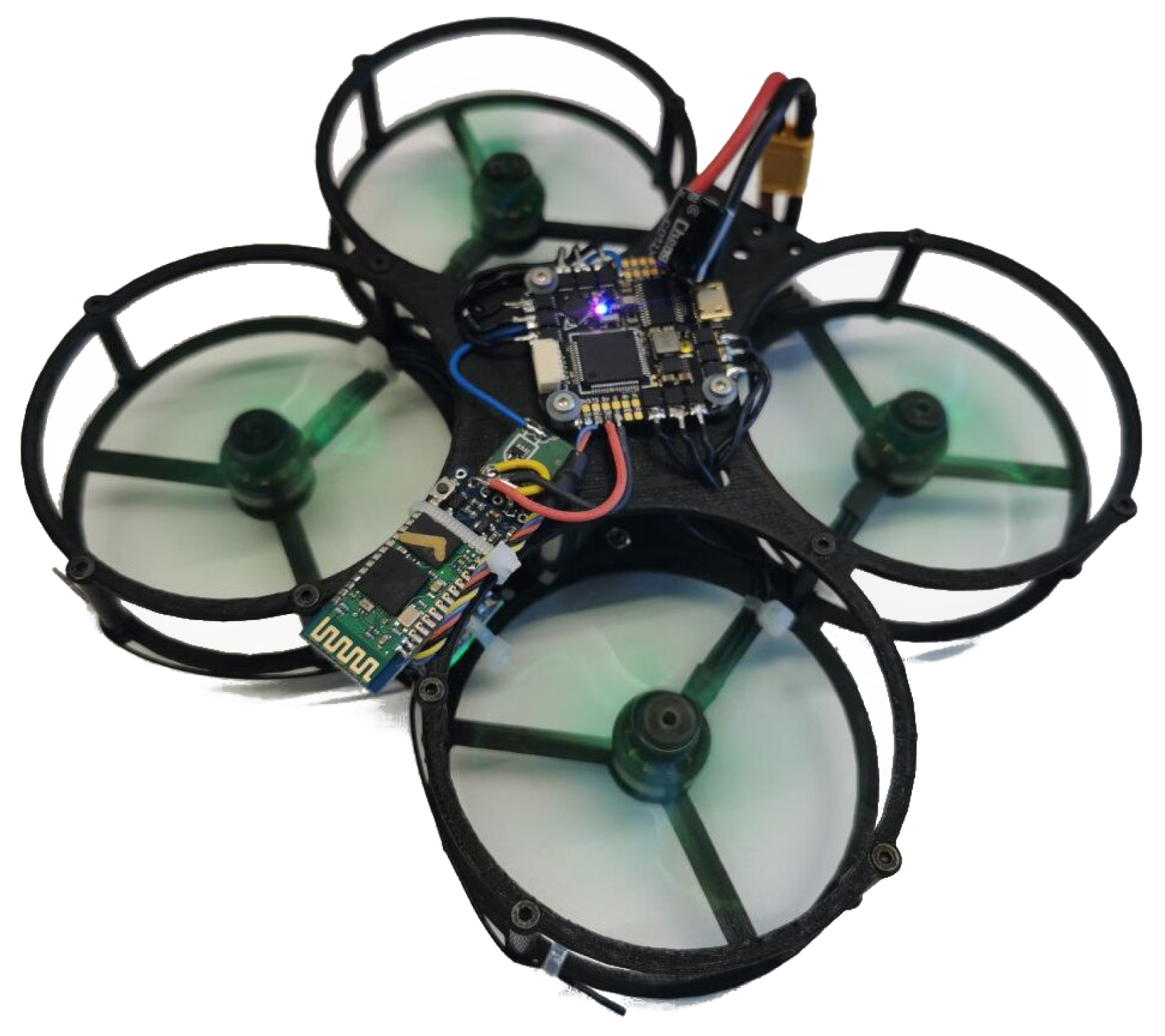
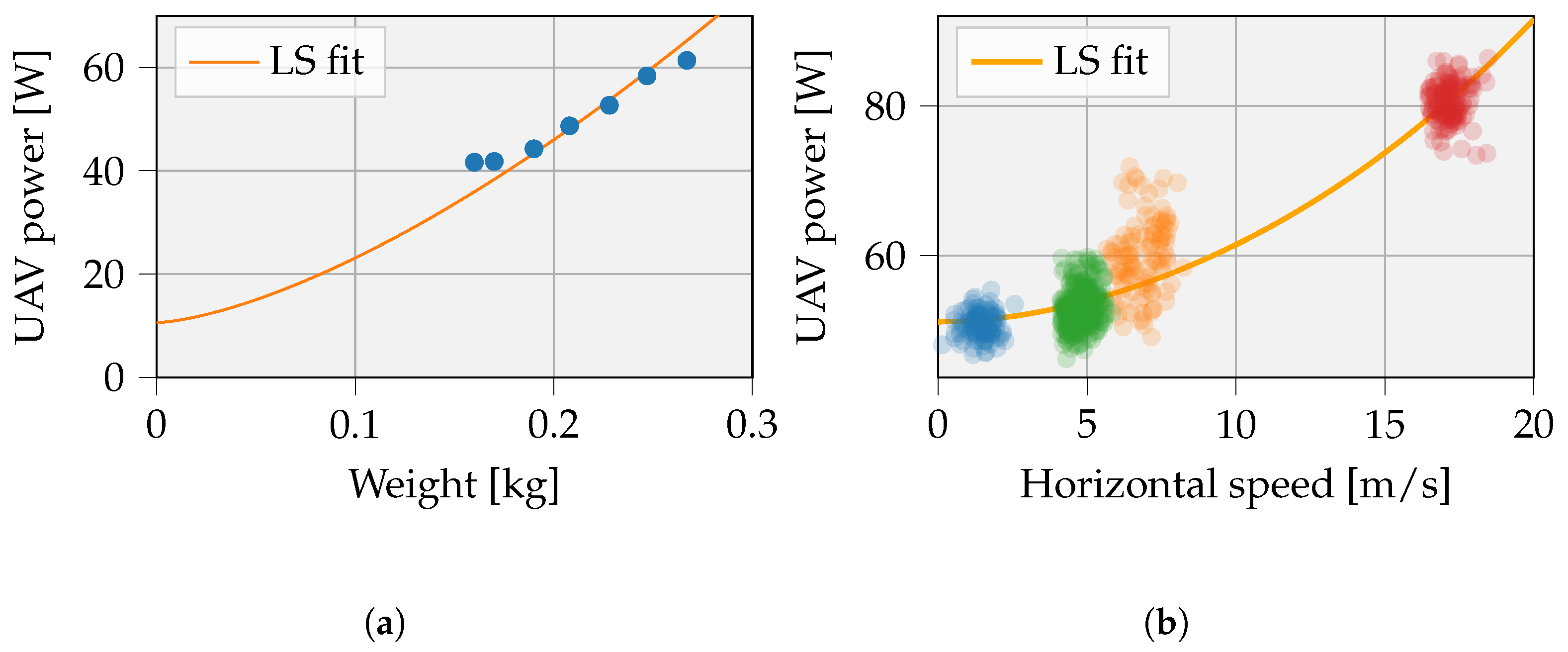


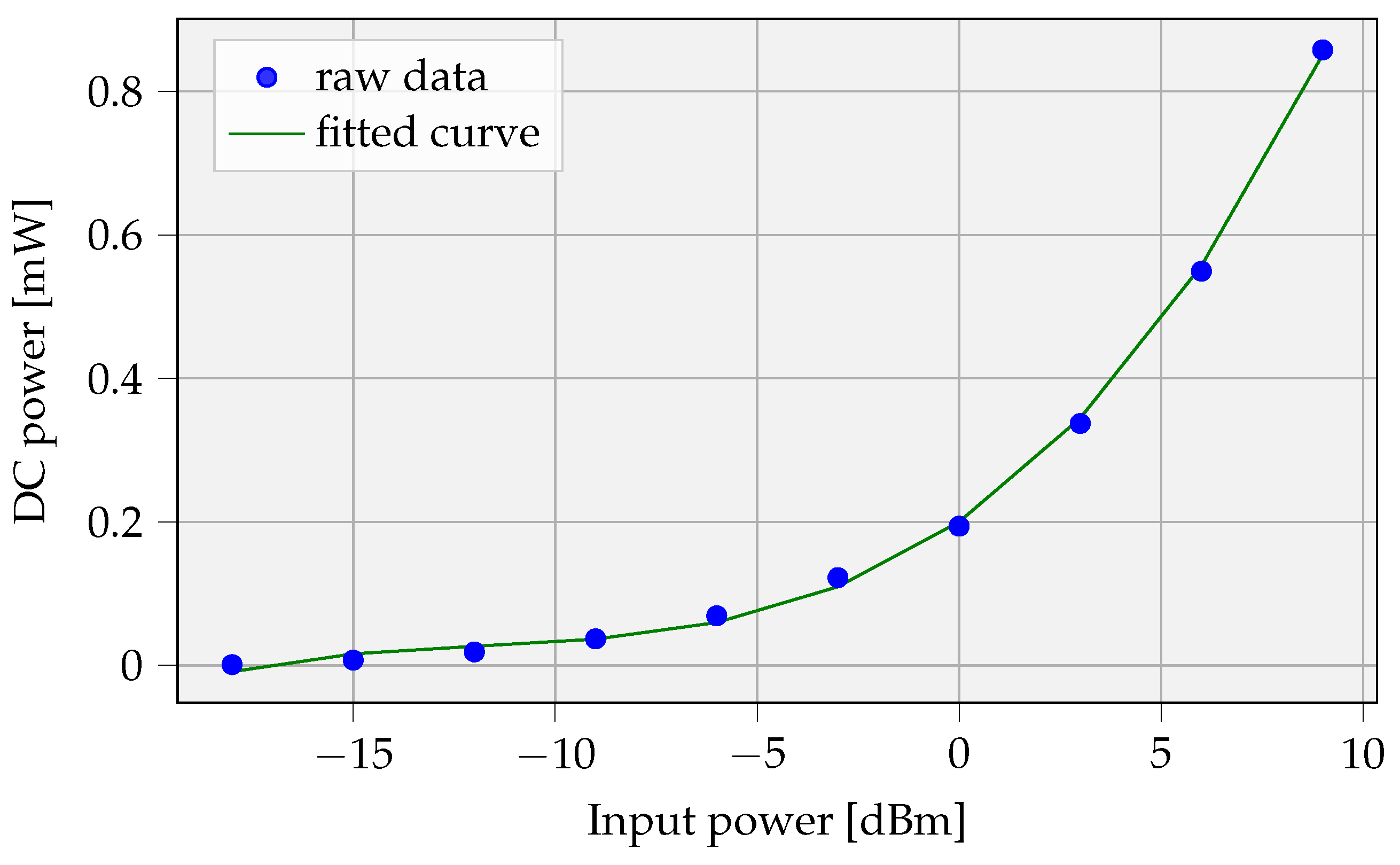


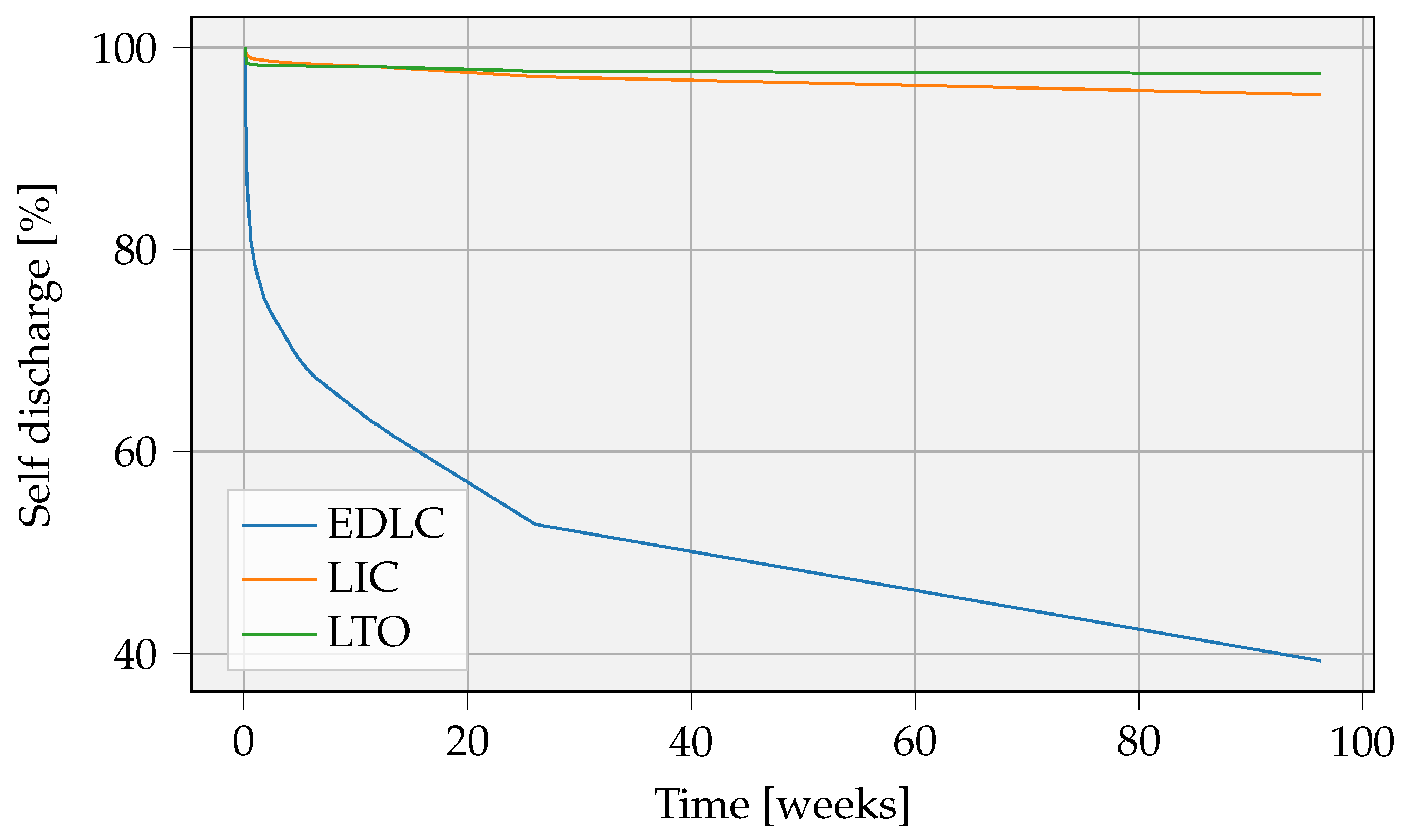
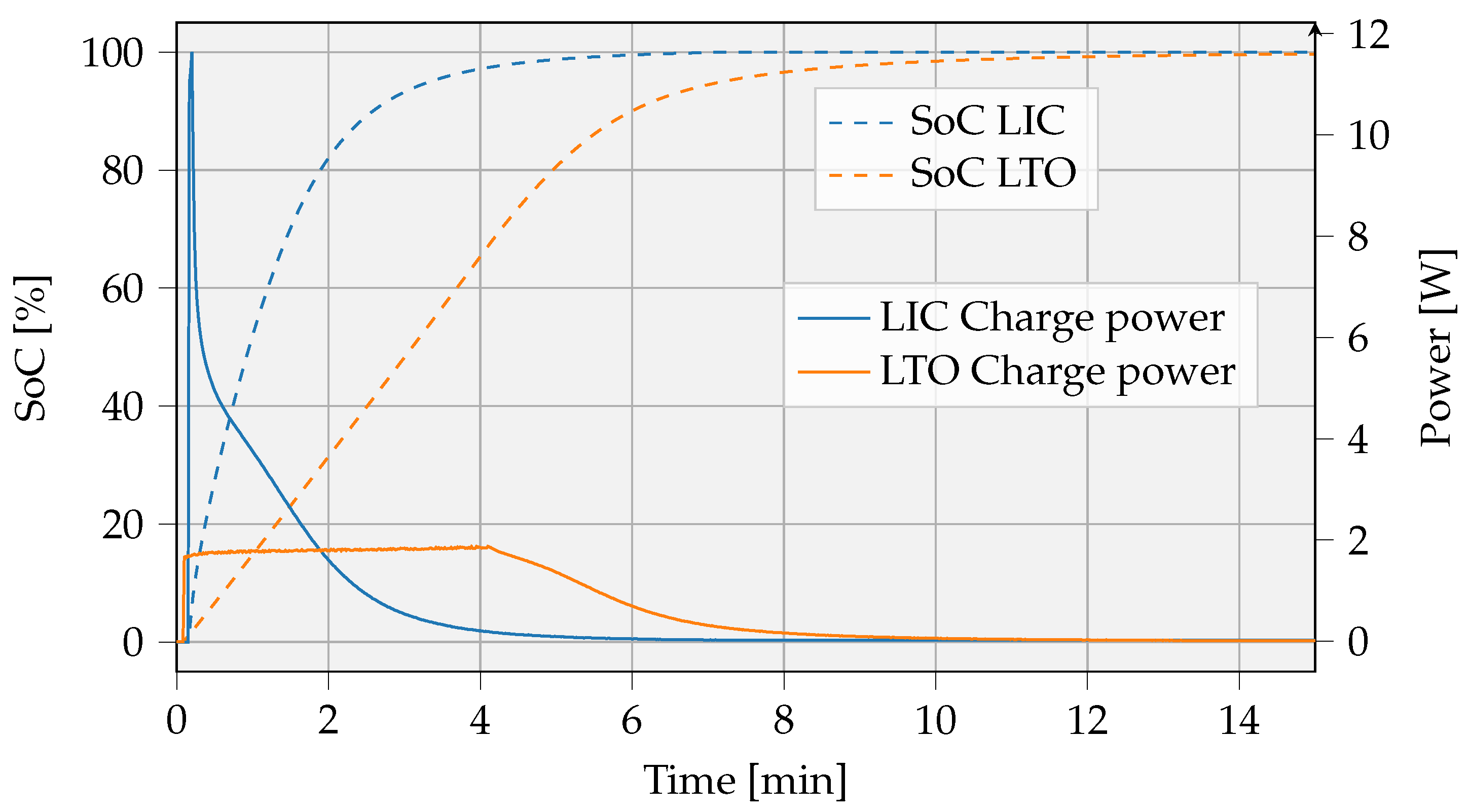
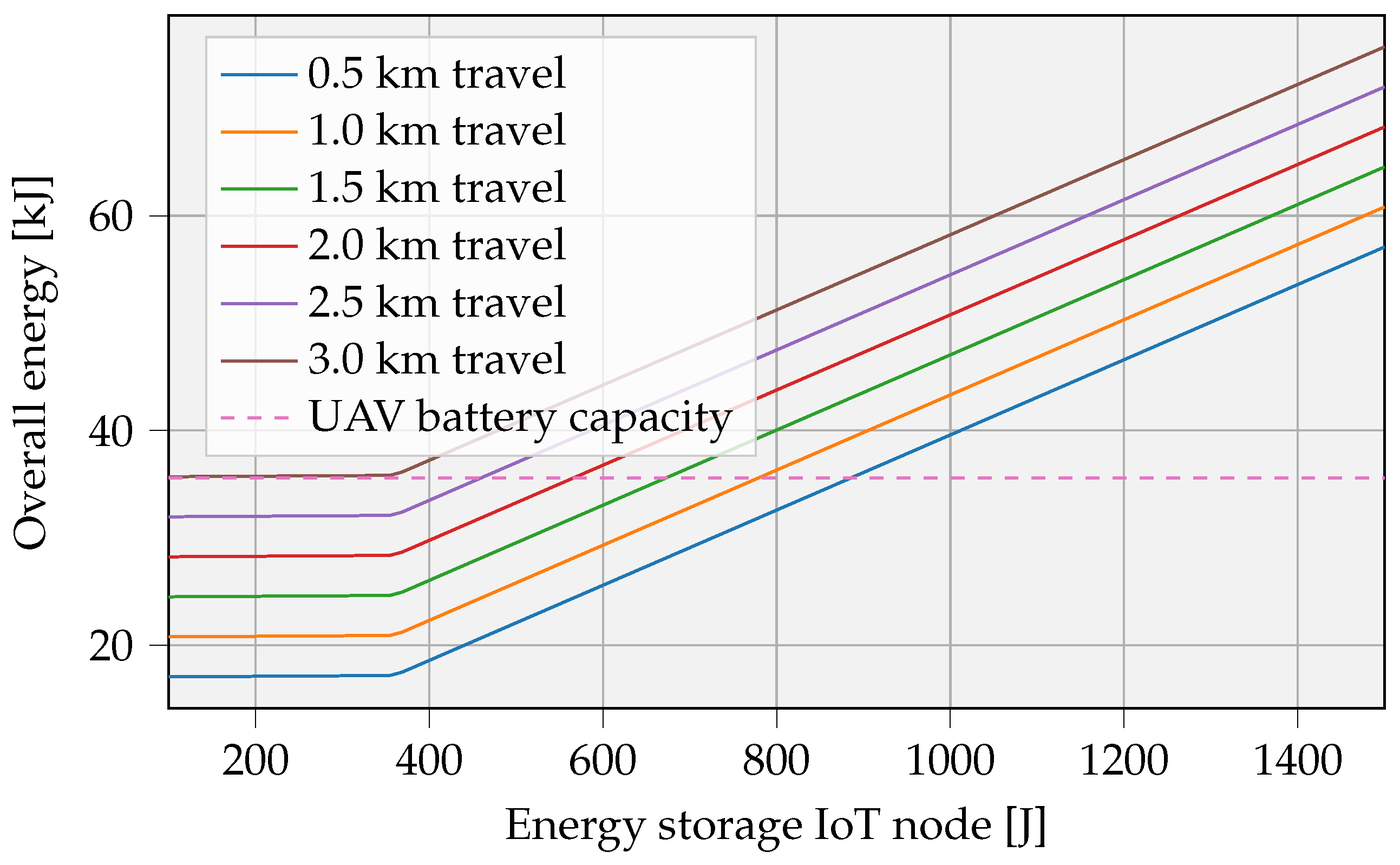
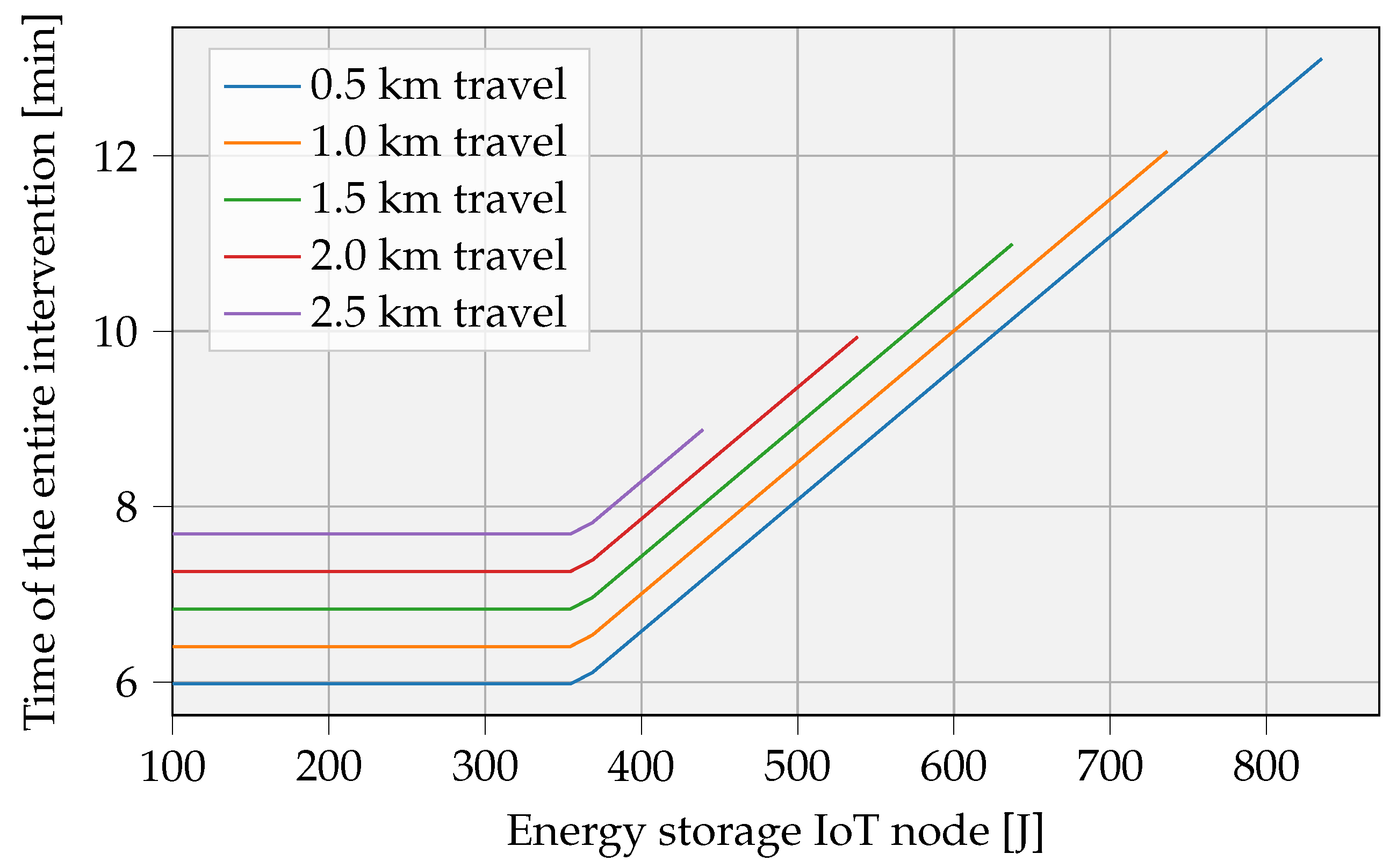
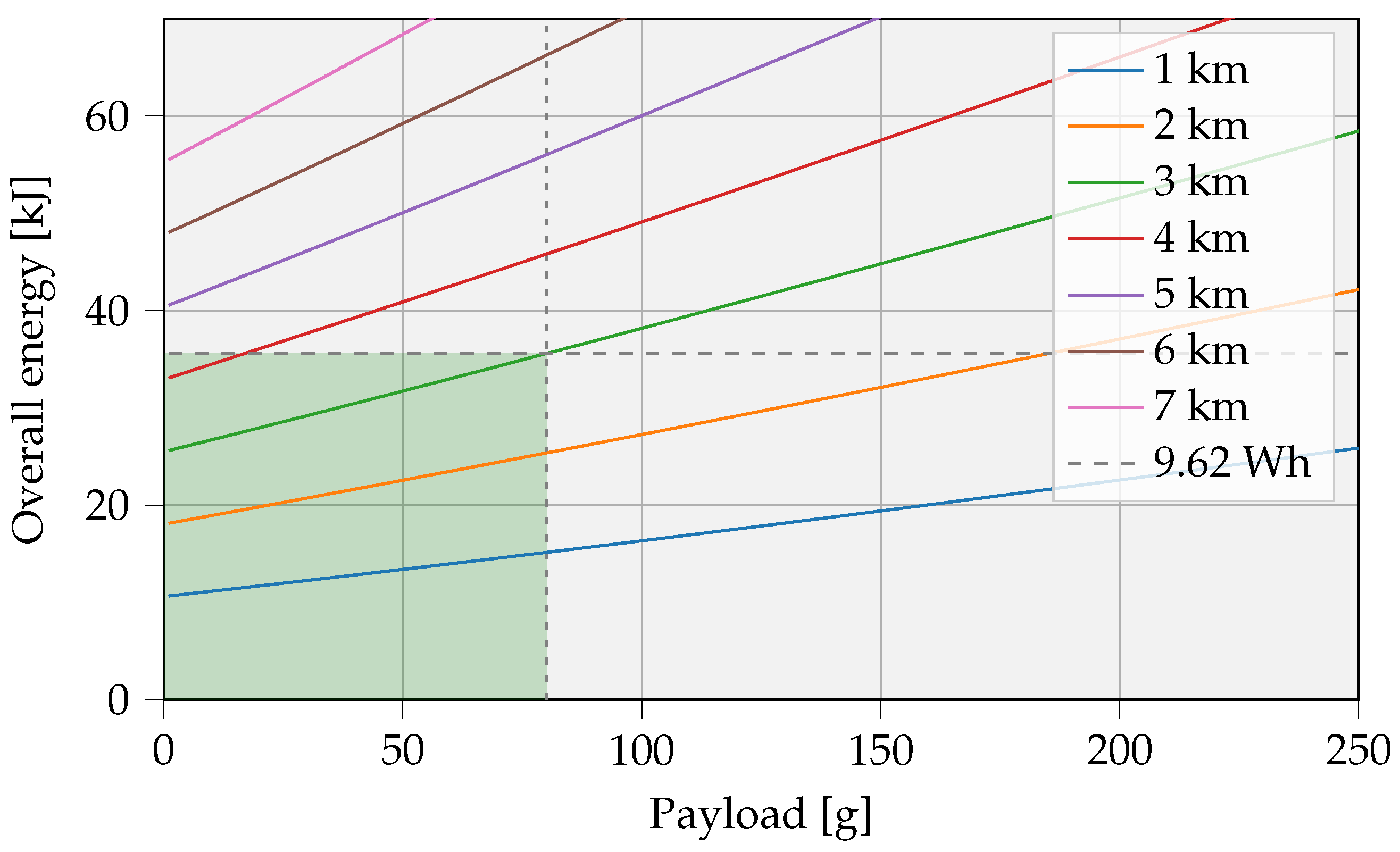

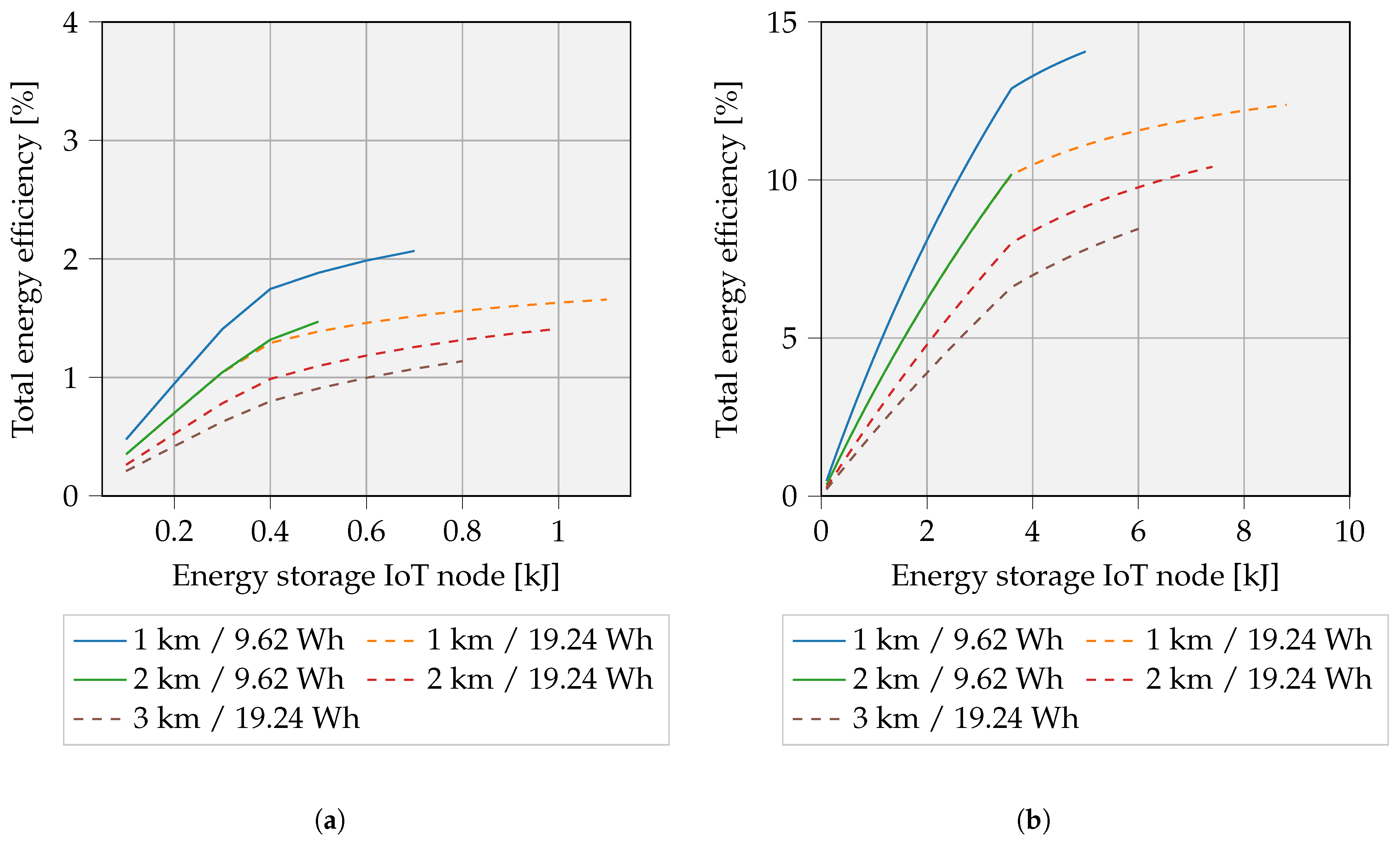

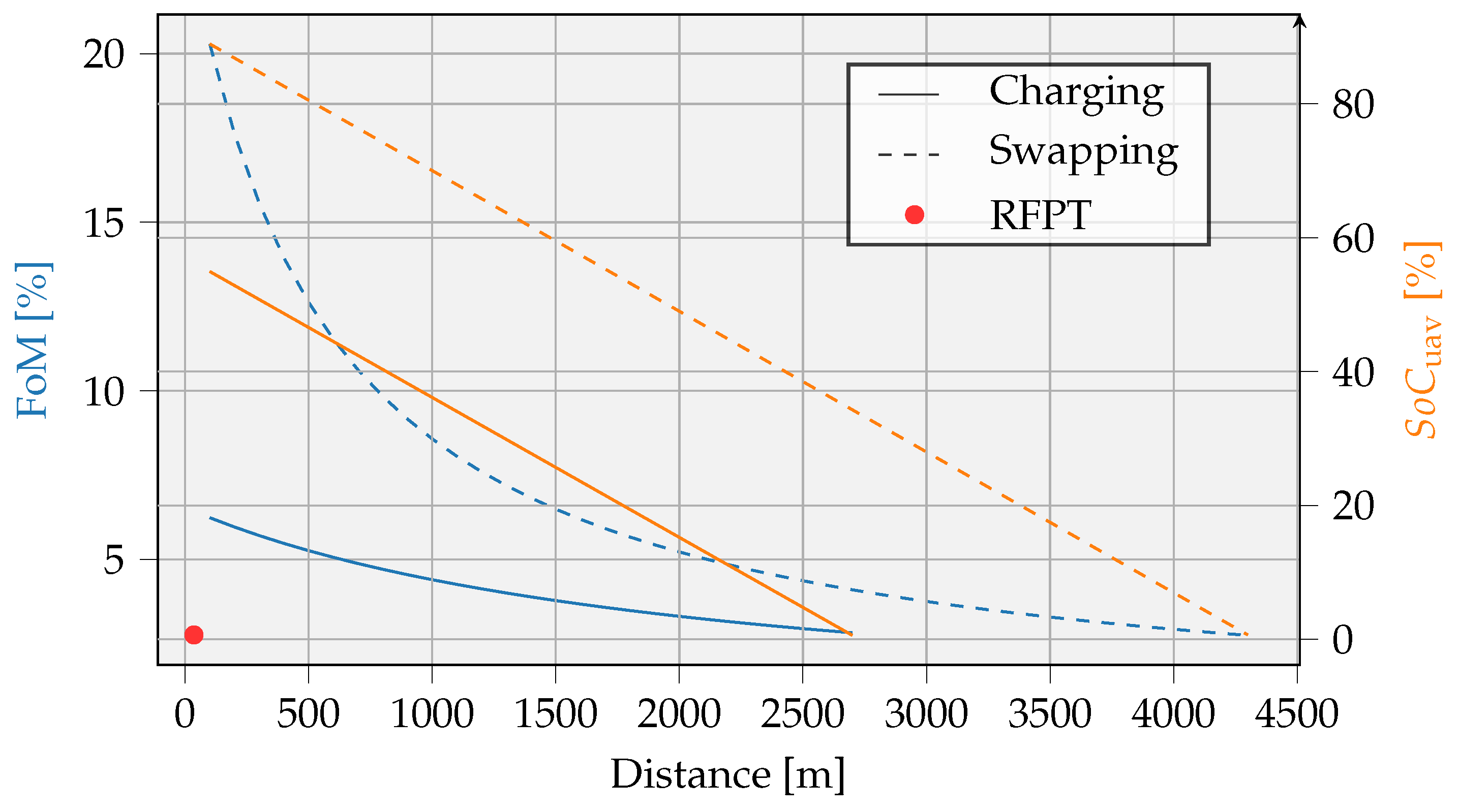

| Parameter | Value [-] | Parameter | Value [-] |
|---|---|---|---|
| 1.560 | 9.451 | ||
| 0.467 | −0.0037 | ||
| 3.428 | −0.0044 |
| DC Power (mW) | RF Input Power (dBm) | Max Distance (m) |
|---|---|---|
| (Required) | (Harvester) | (EIRP 38.15 dBm) |
| 0.01 | −14.15 | 14.5 |
| 0.05 | −7.62 | 6.9 |
| 0.1 | −3.88 | 4.7 |
| 0.5 | 5.43 | 1.6 |
| 1 | 10.06 | 0.9 |
| (x, y, z) [mm] | M [μH] | [μH] | [mΩ] | [μΩ] | [mΩ] | [-] | [%] |
|---|---|---|---|---|---|---|---|
| (0, 0, 100) | 0.083 | 2.165 | 489 | 3.488 | 612 | 0.035 | 76.5 |
| (0, 0, 150) | 0.032 | 2.166 | 488 | 3.483 | 610 | 0.014 | 51.0 |
| Composition | Weight Energy Density [] | Reference |
|---|---|---|
| NMC | ≈217 | [33] |
| LFP | ≈114 | [34] |
| NCA | ≈237 | [35] |
| LTO | ≈80 | [31] |
| NiCd | ≈36 | [36] |
| NiMH | ≈86 | [37] |
| Cf. nr. | Scenario | Payload | IoT Battery Composition | # UAV Batteries | Distance [km] | Storage Capacity [kJ] | Remaining [%] | FoM Value [%] |
|---|---|---|---|---|---|---|---|---|
| 1 | Charging | 0 g | LTO | 1 | 2.5 | 1.8 | 0.3 | 5.1 |
| Swapping | 80 g | NCA | 1 | 2.5 | 68.3 | 14.4 | 69.2 | |
| 2 | Charging | 59 g | LTO | 2 | 3.7 | 5 | 0.8 | 7.1 |
| Swapping | 64.9 g | NCA | 2 | 6.3 | 5 | 7.8 | 7.1 | |
| 3 | Charging | 59 g | LTO | 2 | 1 | 4 | 46.5 | 10.5 |
| Swapping | 63.7 g | NCA | 2 | 1 | 4 | 80.0 | 22.0 | |
| 4 | Charging | 59 g | LTO | 2 | 4 | 4 | 6.5 | 6 |
| Swapping | 63.7 g | NCA | 2 | 4 | 4 | 39.4 | 8.5 |
| Parameters | Charging | Swapping | |
|---|---|---|---|
| Size of depleted IoT battery | [J] | 1000 | 1000 |
| No. UAV batteries | (−) | 1 | 1 |
| [W] | 10 | N/A | |
| (−) | 10 (LTO) | N/A | |
| (%) | 50 | N/A | |
| Weight energy density IoT battery | () | N/A | 237 (NCA) |
| (g) | 0 | 1.17 | |
| (s) | 324 | 60 | |
Disclaimer/Publisher’s Note: The statements, opinions and data contained in all publications are solely those of the individual author(s) and contributor(s) and not of MDPI and/or the editor(s). MDPI and/or the editor(s) disclaim responsibility for any injury to people or property resulting from any ideas, methods, instructions or products referred to in the content. |
© 2023 by the authors. Licensee MDPI, Basel, Switzerland. This article is an open access article distributed under the terms and conditions of the Creative Commons Attribution (CC BY) license (https://creativecommons.org/licenses/by/4.0/).
Share and Cite
Van Mulders, J.; Cappelle, J.; Goossens, S.; De Strycker, L.; Van der Perre, L. UAV-Based Servicing of IoT Nodes: Assessment of Ecological Impact. Sensors 2023, 23, 2291. https://doi.org/10.3390/s23042291
Van Mulders J, Cappelle J, Goossens S, De Strycker L, Van der Perre L. UAV-Based Servicing of IoT Nodes: Assessment of Ecological Impact. Sensors. 2023; 23(4):2291. https://doi.org/10.3390/s23042291
Chicago/Turabian StyleVan Mulders, Jarne, Jona Cappelle, Sarah Goossens, Lieven De Strycker, and Liesbet Van der Perre. 2023. "UAV-Based Servicing of IoT Nodes: Assessment of Ecological Impact" Sensors 23, no. 4: 2291. https://doi.org/10.3390/s23042291






